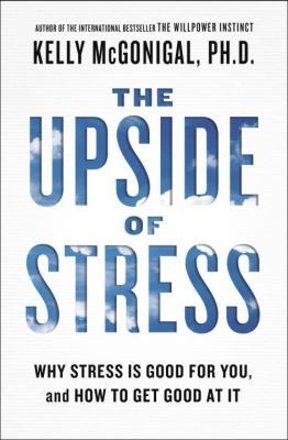- Operating system: Stress is built into how we function in the world. We can learn to harness and even appreciate stress in ways that enhance our resilience and even bravery.
- Priorities: The feeling of stress can let us know that something important is at stake.
- Turbo mode: Stress triggers actual biological reactions to help you cope with the reality you are experiencing.
- Maximize: The biological reactions to stress can increase our feelings of enthusiasm and confidence. Wound repair and immune function improve. Certain reactions can lessen feelings of anxiety and depression.
- Future Benefit: Increased brain activity during stressful situations can prepare us for similar situations in the future.
- Mindset: A flexible mindset allows us to the see harmful and helpful aspects of stress, and then to choose the upside.
We’ve all heard that stress is toxic. The fear of it as a destructive force is ingrained in us from a young age, as many of us are taught to actively avoid and reject stress in our lives. Kelly McGonigal embraced this simple message for years as a health psychologist until research, surprisingly, began to point to very different conclusions: stress has the potential to be a constructive and valuable tool in our lives. The Upside of Stress dives deeper into understanding the biology of stress and how embracing those reactions provides focus and energy, strengthens relationships, and increases quality of life.
Defining Stress
In its broadest sense, stress is the body’s reaction when something valued is at stake (p. xxi).
There are varying degrees of stress, so not all stress reactions can be considered trauma (p. 41).
A stress response is the supportive biological reaction that occurs in stressful situations that allows the person to cope with what they are experiencing (p. 37).
“The stress response is more than a basic survival instinct. It is built into how humans operate, how we relate to one another, and how we navigate our place in the world. When you understand this, the stress response is no longer something to be feared. It is something to be appreciated, harnessed, and even trusted” (p. 62).
The Three Types of Stress Responses
- The fight-or-flight response is a natural physical and protective instinct that has little use in our modern world except when a person’s body is anticipating physical harm (pp. 46-47). The body’s reaction during this response is to constrict blood vessels to minimize the loss of blood and mobilize immune cells for inflammation support. This reaction creates emotions such as fear, anger, self-doubt, or shame (pp. 110-111).
- The challenge response prepares the body for action when it is in a situation that requires performing under pressure. This response allows the body to feel safer and respond by maximizing blood flow and strengthening the heartbeat to produce more energy. A challenge response creates emotions such as excitement, enthusiasm, and confidence (pp. 110-111).
- The tend-and-befriend response motivates the body to connect with others and reach out to their support system. This response is influenced by the hormone oxytocin that builds and strengthens social connections, dampens the fear response, and generates courage (pp. 52-53).
Biology of Stress Responses
A stress response stimulates activity throughout the body. In the brain, senses are alerted through adrenaline, pupils dilate for greater perception, hearing sharpens, brain processes occur more quickly, and the mind focuses so that inferior priorities do not conflict with the situation. A chemical combination of endorphins, adrenaline, testosterone, and dopamine also increases to boost motivation. This creates an increased sense of confidence and power (pp. 50-51).
The two hormones specifically dedicated to stress are cortisol and DHEA. Cortisol allows the body and brain to maximize energy by suppressing other biological functions that are less important than stress, such as digestion and growth. DHEA strengthens the brain during a stress response to allow for wound repair and immune functioning (p. 9).
The growth index is the ratio of DHEA to cortisol. A low growth index has low levels of DHEA and can be associated with negative outcomes, such as depression. A high growth index has high levels of DHEA and has positive outcomes to stress responses, such as reduced risk of anxiety, depression, and neurodegeneration (p. 9).
Stress hormones increase brain activity after a stress response to support learning and memory. This allows the brain to reflect on stressful experiences so that past experiences can condition and prepare the brain and body for how to react to future stress (p. 54-55).
Three types of brain activity occur as part of a tend-and-befriend stress response. The social caregiving system of the brain is activated, allowing the person to feel more empathy, connection, and trust while inhibiting the fear center of the brain. The reward system of the brain is activated, increasing motivation while further dampening fear. Finally, activation of the attunement system enhances perception, intuition, and self-control. This activity in the brain allows the person to experience social, courageous, and intelligent emotions (p. 138).
Mindset Intervention
A mindset is a belief that creates bias in how you think, feel, and act (p. 11).
Mindset interventions present a new perspective that may not have been considered before and serve as catalysts for changes in behavior (p. 22).
An effectively implemented mindset intervention will create a permanent change in behavior for the foreseeable future, not just for one occasion (p. 102).
“The most helpful mindset toward stress is one that is flexible, not black or white: to be able to see both sides of stress but choose to see the upside; to feel your own distress and yet also decide to focus on how that stress connects to what you care about” (pp. 34-35).
A growth mindset is the idea that setbacks are inevitable and that obstacles are opportunities to draw on one’s resources to successfully counter current and future setbacks (p. 191).
The two components of a growth mindset are shifting and persisting. Shifting involves acknowledging stress and the source of that stress. Persisting relates to remaining optimistic when being faced with the adversity created through stressful situations (p. 194).
Post-traumatic growth occurs when a traumatic experience creates great suffering but also motivates the person to create positive change (p. 198).
“Seeing the upside of adversity changes the way people cope. People who find benefit in their difficulties report more purpose in life, hope for the future, and confidence in their ability to cope with the current stress in their lives” (p. 203).
Engaging in a Mindset Intervention
A mindset intervention is a three-step process that should be used for practicing a stress-is-good mindset during a stressful experience (p. 29).
- First, acknowledge the stress when experiencing it.
- Second, welcome the stress by recognizing that it is a response to something you care about and its connection to your values.
- Third, make use of the energy the stress gives you to confront the problem.
The most effective mindset interventions involve (1) learning the new point of view, (2) practicing an exercise that encourages the adoption and application of the mindset, and (3) providing an opportunity to share the experience with others (p. 30).
The Threats of Stress
A 1998 research study found that high levels of stress increased the risk of dying within eight years by 43% if and only if the person considered stress to be harmful. It is not stress alone that has a negative effect, but the presence and belief that stress is harmful (p. xii).
Stress generation occurs when a person seeks to avoid stress. The result of this is that more stress is brought on while supportive resources for a stress response are further depleted (p. 84).
“Avoiding what makes you feel anxious only reinforces fears and increases worrying about future anxiety” (p. 108).
Compassion collapse occurs when a person witnesses another in a stressful situation and seeks to avoid the stress of the other’s situation. A compassion collapse stress response results in the viewer becoming paralyzed rather than mobilized (p. 140).
The Opportunities of Stress
A research experiment conducted at investment banking company UBS determined that mindset interventions transmitting the message that stress is helpful influenced employee wellbeing. Employees reported less anxiety and fewer health problems and were observed as being more engaged, collaborative, and productive (pp. 19-20).
A research study by Karen Parker was conducted with monkeys to determine if stressful situations in one’s youth create future negative ramifications. The study concluded that a daily dose of stress creates resilience, increased trends toward curiosity, increased courage, greater intelligence, and enhanced self-control. Biologically, those who experience a daily dose of stress tend to have dampened fear responses, increased positive motivation, and strengthened impulse control (pp. 44-45).
An international survey was conducted to identify if a correlation existed between a nation’s stress index and the nation’s wellbeing, GDP, and life expectancy. The survey reported that a higher stress index was found in nations with higher wellbeing, GDP, and life expectancy. This is referred to as the stress paradox – a relation of high levels of stress to levels of wellbeing (pp. 63-64).
“Stress is an inevitable consequence of engaging in roles and pursuing goals that feed our sense of purpose” (p. 65).
Business Growth Strategies for Stress Responses
Companies dealing with hardship are most successful when taking a collectivistic approach with their policies, decisions, and employee involvement (p. 152).
“Helping others reduces feelings of hopelessness and depression when in trauma” (p. 156).
Business leaders who apply bigger-than-self goals in the workplace to key decisions and actions can best support and assist their organization and employees to rebound from adversity (p. 151).
“When people are connected to bigger-than-self goals, they feel better: more hopeful, curious, caring, grateful, inspired, and excited. In contrast, when people are operating from self-focused goals, they are more likely to feel confused, anxious, angry, envious, and lonely” (pp. 145-146).
Personal Growth Strategies for Stress Responses
Reflecting on and writing about one’s values during and after moments of stress aids in coping and finding meaning in life. The process of writing about one’s values and how stressful situations relate to these values has been shown to increase work and school performance, reduce visits to the doctor, and improve mental health (pp. 70-74).
“When people are connected to their values, they are more likely to believe that they can improve their situation through effort and the support of others” (p. 71).
The body undergoes an evaluation of strengths and weaknesses when presented with a challenge or threat response. The person experiences a challenge response if they feel equipped with the necessary skills to conquer the situation. A threat response is experienced if they feel they are incapable of succeeding (p. 113).
A person ought to acknowledge personal strengths and reflect on similar past situations where a lesson was learned or an obstacle was eliminated. This practice promotes a challenge response rather than a threat response (p. 113).
“When you view stress as inevitably harmful and something to avoid, you become more likely to feel all of these things: doubt about your ability to handle the challenges you face, alone in your suffering, and unable to find meaning in your struggles. In contrast, accepting and embracing stress can transform these states into a totally different experience. Self-doubt is replaced by confidence, fear becomes courage, isolation turns into connection, and suffering gives rise to meaning. And all without getting rid of the stress” (pp. 220-221).

“Accepting and embracing stress can transform these states into a totally different experience. Self-doubt is replaced by confidence, fear becomes courage, isolation turns into connection, and suffering gives rise to meaning. And all without getting rid of the stress.”

